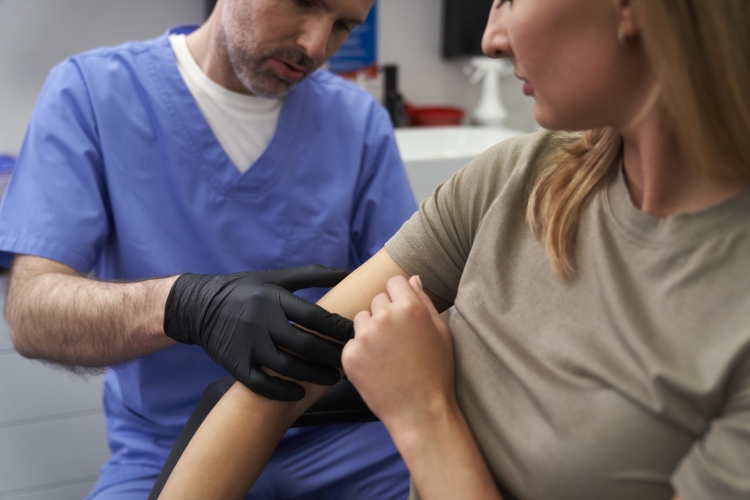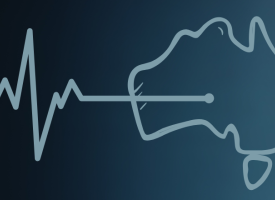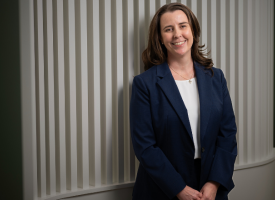Transcript: ABC Radio Adelaide - Health workforce planning
During a lengthy discussion on ABC Radio Adelaide Mornings, AMA SA President A/Prof Peter Subramaniam explained that delays accessing non-GP specialist care are a symptom of a bigger challenge in South Australia's health system.

Transcript: AMA SA President Associate Professor Peter Subramaniam on ABC Radio Mornings with Rory McClaren.
(5 August, 2025)
Subjects: access to care, workforce sustainability, non-GP specialists, waiting times
Rory McClaren: We had a call from Wayne in the statewide soapbox part of our programme, which we try to get to at about quarter to 11 each day. Wayne was highlighting his frustration with the wait times to see a specialist.
Wayne (caller): I made an appointment, got a referral to a specialist immunologist by the GP, and going out to see them as a private patient, there's a seven-month wait.
Rory McClaren: Even as a private patient?
Wayne: Even as a private patient. I looked up on the website for the Southern Local Health Network. You can be waiting up to 50 months. But even the private sector – seven-month wait – wow, that seems quite a while. So there's obviously a lack of specialists in certain areas in Adelaide, not just GPs. You've got to look at the specialist side of things as well and try and attract them somewhere along the line.
Rory McClaren: So again, just so we're clear here, Wayne, it was an immunologist you were seeing?
Wayne: An immunologist, yes. I did see his father some years ago and had treatment for an allergy that seems to have worked according to the blood test. But there is still something there that's causing quite a few issues. And I need to see someone because if I wait seven months, I'll probably need surgery again.
Rory McClaren: So that was Wayne speaking to us yesterday on the morning's programme, and we had other people texting and calling about similar issues. We've gone away and looked at the data published by SA Health on a quarterly basis about wait times in the public sector. It shows that in quite a few cases, wait times have increased over the last 12 months. Median cases have risen in most examples – the worst being ENT specialists, from 9 to 18 months at the Royal Adelaide, with a maximum wait time of 39 months.
Reading data tables can be quite confusing, so to talk us through it all, we're joined now by Associate Professor Peter Subramaniam, President of the Australian Medical Association SA Branch. Welcome back to the programme, Peter.
A/Prof Peter Subramaniam: Thank you, Rory, and good morning to your listeners.
Rory McClaren: Let’s talk about these latest figures. It shows median wait times up to 23 months for orthopaedics and a maximum of 78 months for neurology at the Royal Adelaide Hospital. How did we get there?
A/Prof Peter Subramaniam: I think these are numbers that demonstrate a problem with our system – a challenge. Like outpatient services, ambulance ramping, and elective surgery waitlists, these are symptoms of a deeper system issue. Your listener who had to wait seven months for a private immunology appointment is an example of where we need to map the workforce to ensure we've got the right number of specialists in the right positions.
I actually checked in with the head of immunology at the Royal Adelaide Hospital to get some background. My understanding is that many private immunologists are moving into the public sector, and as a result, the number of private immunologists has dropped off – especially for paediatric patients. This is happening because there are gaps in the public sector that need to be filled.
But access isn’t just about getting an appointment. Appointments need to be processed properly. Sometimes the information provided is inadequate, and it has to go back to the referring GP for more detail. So it’s not just a workforce issue – it’s also about making sure doctors have the time and systems to triage appropriately. Waiting a long time to see a specialist, whether in the private or public sector, means there’s a risk of getting sicker.
Rory McClaren: Peter, is it unusual to see immunologists move from the private sector into the public sector?
A/Prof Peter Subramaniam: Oh no, it’s not unusual. Immunologists are a small group, and their work often requires access to pathology services and complex testing, which is easier to manage in the public sector. So yes, we’re seeing that shift.
The wait times also vary by specialty. ENT, urology, orthopaedic surgery – these are areas where volume is the issue. We simply don’t have enough capacity in the public system to see patients in a timely fashion. That’s why the AMA has called for standardised processes to ensure referrals are reviewed, patients are seen, and GPs get feedback in a timely way. That’s not happening consistently right now.
Rory McClaren: You mentioned volume in some specialties. What are some of the other major factors driving these long waits? Is it workforce shortage?
A/Prof Peter Subramaniam: That’s certainly a big part of it. But it’s also about having a coherent statewide outpatient strategy. We’ve got three major public hospitals – Royal Adelaide, Queen Elizabeth, and Flinders – and we can’t continue to operate in silos. If you get a quicker appointment at Flinders than at Royal Adelaide, we need to be able to coordinate that better across the system.
Rory McClaren: That is the voice of Peter Subramaniam. He is the state president of the Australian Medical Association here in South Australia at quarter past nine. Renee has called in to share her family's story. Hello, Renee.
Renee (caller): Oh, hi, Rory. Thanks for taking my call.
Rory McClaren: What's your experience when it comes to trying to see a specialist?
Renee: So our little boy, he has a disability and he has seizures and we live out in the country. We had a phone call from his school at the end of last term saying that he was walking with quite a lag in his right leg. They were concerned about his walking and said it could be linked to his seizure medication. I instantly rang his paediatrician and the earliest we could get him in was September – and this was back in June. It’s incredibly frustrating. And that’s through private – we’re private with everything. We’ve got a good team on board, don’t get me wrong, great doctors.
Rory McClaren:
But it’s just so frustrating. Yeah. And how is your son at the moment?
Renee: Look, he's going a lot better now. We did get him to see our local GP and we do have great doctors here in the country when we can get him to see them. But yeah, obviously, we still need to see his paediatrician to make sure we’re ticking all the right boxes. And obviously, yeah, we are out in the country too.
Rory McClaren:
Well, Renee, thank you for calling in and sharing your experience. I do hope all goes well when you do get to the paediatrician in September.
Renee: Thank you so much.
Rory McClaren: Thank you for your call. Back to you, Peter. Can we talk about that very issue that Renee's highlighted there? Are these waits statewide? Or are things worse in the regional areas?
A/Prof Peter Subramaniam: Exactly. What we've heard is the voice of a concerned parent. Renee talked about trying to access private paediatric neurology services – another area like immunology where there are limited numbers in the private sector. The solution in situations like this, especially in rural and regional areas, is connecting the local GP with specialist services.
We have public paediatric neurology services at the Women’s and Children’s Hospital and at Flinders. There are also some private options. But the key for Renee is confidence – that when her child needs to see someone, they can be seen in a timely fashion, and that the GP receives communication to support the family during the wait. That’s where statewide coordination and having the right number of paediatric neurologists is essential.
Rory McClaren: Let’s now go to Richard. Hello, Richard.
Richard (caller): How are you? Seven months was the wait I had to do. Actually, no – it’s eight months for a child for a dermatology issue. I thought that was pretty excessive. But my question is – I heard this same issue about lack of specialists and GPs five years ago on this same station. Probably 10, 15 years ago too. We know this problem. It takes about 10 years to train a specialist. So what was done 15, 20 years ago? What’s being done now? My question is – how have GP numbers increased? How have specialist numbers increased over the last 10 to 15 years? Surely they have. Because if they haven’t, then the bureaucrats aren’t doing their job.
Rory McClaren: Richard, thank you for your call. Back to you, Peter. How are we tracking when it comes to national measures around the number of specialists in South Australia compared to other jurisdictions?
A/Prof Peter Subramaniam: Yes, I think Richard has asked the key question – where is the pipeline? Are we training enough doctors and specialists? Are we putting them in the right spots? Richard is 100% correct. You don’t materialise a paediatric dermatologist unless you employ them from out of jurisdiction. And we’re not just in South Australia looking for dermatologists – every other state is doing that too.
We have a strong reliance on international medical graduates. They’re an important part of delivering services, and we need to facilitate onboarding them. We need to plan for a workforce for South Australia. As Richard pointed out, we talked about the problem 10 or 15 years ago, and we’re still here. In fact, in some respects, we’re going backwards. That’s why the AMA has called for a formal mapping of our workforce requirements and a strategy to plan for medical specialists and GPs.
Rory McClaren: To be fair, Peter, I think that’s a call that other parts of the public health workforce – SASMOA, the Salaried Medical Officers Association – have been making for a long time as well. It’s also an issue that Yvonne has picked up on the text line. She says:
Text from Yvonne: Hi Rory, it really is a workforce issue. Doctors are trying to get into specialist programmes but the specialist colleges only take a few into the programmes. Those doctors are brilliant but are turned away. We should demand that the colleges take on more students into the specialist programmes.
Rory McClaren: Is that part of the solution here potentially, Peter?
A/Prof Peter Subramaniam: It is part of the solution. In fact, we have created – when I say "we", I mean the system – more capacity to train GPs. One of the challenges for the colleges is that you need to have the right number of training posts. And those training posts need to be expanded.
For example, as a surgeon, I would need to train in a centre that allows me to perform a certain number of procedures under supervision. That requires the appropriate number of supervising surgeons. That’s a limiting factor for some of the specialty colleges. But Yvonne is absolutely right – if we have a growing population with increasingly complex medical needs, we need to have the right workforce in place. And we need to plan now, not in five years. The colleges are moving toward that, but these things take time.



